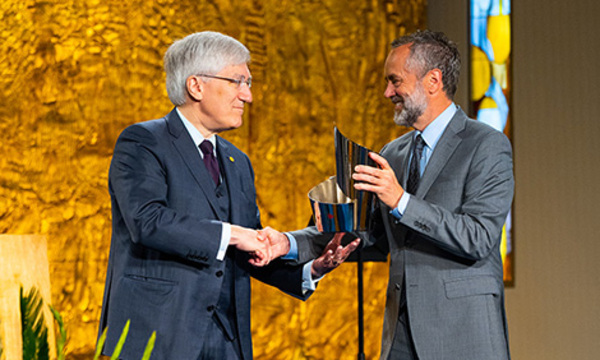
Photos by Greg Schneider
When he was a student at 51¬‹ņÚ‚Äôs School of Education, Dennis Eastman (‚Äô92, M.A. ‚Äô98) learned that the best teachers are those who view their students not as problems to be solved, but rather as lives ‚ÄĒ made in the image of God ‚ÄĒ to be shaped for the better through compassion and relationship.
It‚Äôs a lesson that has helped him in his current job, as principal of ‚ÄĒ a college-prep charter school in Santa Ana where the majority of students are at-risk, many are foster children, and 91 percent are considered economically disadvantaged. But in the three years Eastman has been principal at Nova, he‚Äôs managed to shepherd the school from some of the lowest marks in the district to being a nationally recognized high school success story.
In 2009, Nova Academy received a bronze medal from U.S. News & World Report in its ‚ÄúAmerica‚Äôs Best High Schools‚ÄĚ issue, which awards gold, silver and bronze medals to the top 10 percent of high schools in America, based on college readiness index scores.
The honor is ‚Äúa validation,‚ÄĚ said Eastman, of his relational approach to education that focuses on humanizing the student and getting to know them personally.
Unlike many high schools that have 40:1 student-teacher ratios and function almost like mini cities, Nova Academy ‚ÄĒ which partners with Olive Crest, a Southern California non profit working with abused, neglected and at-risk children ‚ÄĒ is still relatively small and able to have more intimate interaction between students, faculty and staff.
‚ÄúOur model is a family-oriented relational model in an academic setting,‚ÄĚ said Eastman, who is also an adjunct professor at 51¬‹ņÚ, where he teaches everything from classroom management to teaching methods.

‚ÄúIf you were at Nova for a day, you would say there is something different. And what‚Äôs different is a relationship between teacher and student that is very genuine. The teachers care for the students and the students know they are cared for.‚ÄĚ
But Eastman admits that it‚Äôs not always ‚Äúpeaches and cream.‚ÄĚ
‚ÄúEvery day we have triumphs and tragedies,‚ÄĚ he said. ‚ÄúBut the kids know this is a safe place, and it‚Äôs made a huge difference.‚ÄĚ
Whether they are dealing with teen pregnancy issues, substance abuse or any of the other daily struggles of adolescence, many students at Nova have a lot more than school to worry about. Some are just struggling to survive. In some cases these kids are so exhausted from difficult home situations ‚ÄĒ such as violence or extreme poverty and hunger ‚ÄĒ that it‚Äôs easy for things like homework to become an afterthought. So Eastman decided to build in a homework and tutoring period into the school day.
At Nova, Eastman has created a community of selflessness where he and his staff place the progress and well being of students as the top priority. And even though he’s led his school to national recognition and awards, Eastman would be the first to tell you that it’s not about the recognition.
An athlete and self-proclaimed ‚Äúfitness freak,‚ÄĚ Eastman admires what the legendary UCLA basketball coach John Wooden once said: ‚ÄúIt‚Äôs amazing what we can do when nobody cares who gets the credit.‚ÄĚ
As with every other Southern California public school, Nova Academy has had to deal with deep budget cuts in recent years. Eastman sat down with each member of Nova‚Äôs staff last year, asking them if they would agree to a 10 percent pay cut, across the board, as an alternative to eliminating someone‚Äôs job. Every teacher ‚ÄĒ including Eastman and all administrators ‚ÄĒ agreed to take the cut.

This sort of ‚Äú mentality‚ÄĚ ‚ÄĒ where everyone looks out for the needs of others rather than themselves ‚ÄĒ is what Eastman hopes to cultivate at Nova.
‚ÄúOne problem [in the California education system] is that people are all battling for their own little fiefdom,‚ÄĚ said Eastman. ‚ÄúBut I sat across from teachers willing to take a pay cut. Yes, they have bills to pay. Yes, they are breadwinners. But they said, ‚ÄėDon‚Äôt cut another person‚Äôs job. Cut my pay.‚Äô‚ÄĚ
There is a real sense of ‚Äúgiving back‚ÄĚ at Nova, and Eastman exemplifies it. Having been adopted himself as a baby, Eastman knows what it means to be accepted into a family. At Nova, where there are numerous foster kids who sometimes lead very transient lives, shuffled from school to school, Eastman hopes to create a stabilizing force.
A history buff whose office contains a Spartan helmet and a bust of Sophocles, Eastman knows well that teaching is one of the oldest and most important human functions, and an opportunity to mold lives for the better.
‚ÄúYou are literally making followers,‚ÄĚ he said. ‚ÄúAre you going to lead them with an open hand or a closed fist? You have a choice.‚ÄĚ
 51¬‹ņÚ
51¬‹ņÚ
.jpg)

